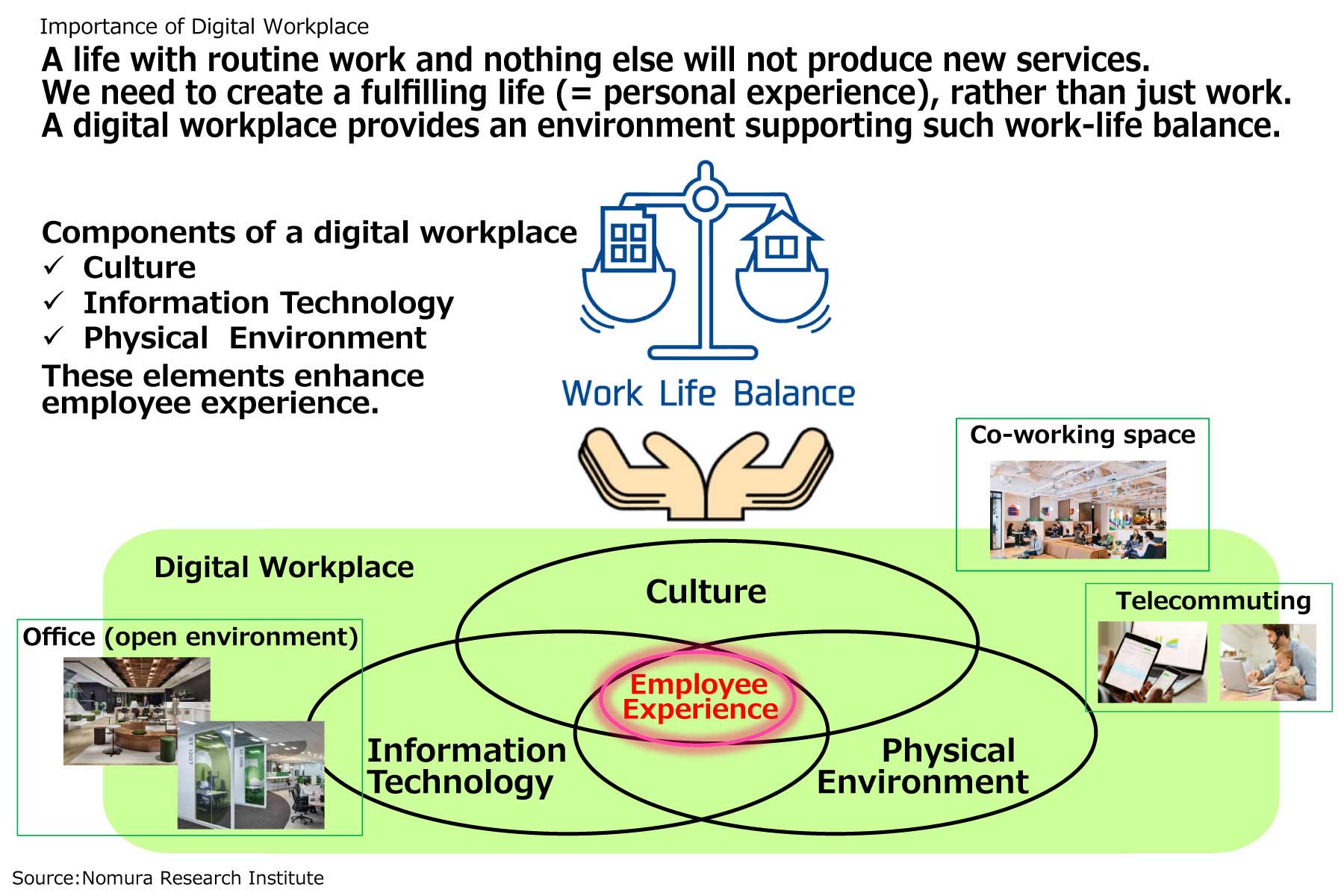
Work-Style Reform and Digital Workplaces
The campaign to “change the way we work”, or work-style reform (hataraki-kata kaikaku), is often discussed with objectives like reducing work hours or improving productivity or is otherwise framed from the employer’s perspective, and this has inspired some to sarcastically call it “changing the way employers make employees work”. NRI believes that the objective should rather be to create a workplace centering on the “employee experience”. In this interview, Hiroshi Kurosaki, who assists companies with building business management systems and designing and implementing work-style reform, discusses key reform points going forward.
Efficiency-oriented reform at a crossroads
――What challenges await businesses that have undertaken work-style reform thus far?

Initially, reforms began with efforts to instruct employees to “go home early” and decrease overtime. Initiatives were later launched to reduce unnecessary duties and automate business processes using robots, and these efforts are starting to bear fruit to a certain degree. Today, some have started questioning whether enhancing business efficiency is the goal of reform, while others point out that, although businesses have said they would use time saved to do more creative work, they haven’t produced concrete results. We’ve come to a crossroads where we must reassess how to proceed with work-life reform going forward.
What we’re proposing is to make an improved employee experience (EX) the objective of work-style reform—that is, creating a workplace environment with a focus on enhancing the experiences of employees at their companies and through their jobs. Over the last few years, human resources officers have paid close attention to EX, contending that workplaces offering a strong EX attract talented professionals, who achieve high levels of performance and remain there for many years. Meanwhile, the conventional work-style reform sought to strengthen time management for each employee as part of a greater aim of increasing productivity, often neglecting employee satisfaction and experience.
Utilizing digital technology to set the stage for a new style of working
――What inspired you to link employee experience (EX) and work-style reform when they had conflicting aspects?
Some businesses undertaking work-style reform believe that they should take into consideration not only productivity and efficiency but also employee motivation and other factors. Moreover, the concept of the digital workplace, a buzzword in the U.S. and elsewhere, centers on EX as well. We wanted to incorporate this digital workplace concept into our thinking of a new way of working.
――The phrase “digital workplace” sounds like an effort to create a space equipped with convenient technology devices to facilitate communication and collaboration.
Such physical aspects tend to grab attention, but a digital workplace represents a broader concept. It’s important to think of digital workplaces as consisting of not only IT, but also performance management that supports employee success and achievement; a sense of values that appreciates constant business evolution; and measures for creating and changing culture. If we consider a digital workplace as a “stage” where employees can gain a positive experience while working, we can develop various measures comprehensively in the contest of work-style reform.

A story that enhances both employee experience (EX) and efficiency
――If we set EX, a core component of a digital workplace, as the ultimate goal, how would this change from measures taken thus far?
In a nutshell, we’ll have broader measures. For instance, if the goal is to simply improve productivity, all you need to do is do away with tasks with low added value and replace workers with robots. But if you want to enhance EX, that won’t be sufficient. To give more challenging jobs to employees so they feel a sense of accomplishment or personal growth, the role of managers becomes more important, and the more subordinates they oversee, the heavier their work burden becomes. If you seek to reduce work hours, it’d be better to drastically cut managers’ work hours and use the time saved to develop and support younger workers. So it’s important to reassess whose work needs more efficiency to save time.
Moreover, if you have your workers telecommute in order to save their commute time and conduct meetings by phone or video, you’ll need to change processes and performance management as well. The ultimate form of a free style of working is similar to meritocracy, but if you just leave your workers in that environment and hold them accountable for whatever happens, this might erode EX. It’s important to build a clear story—for example, having an awareness of the goal you seek to attain and using the time saved in work-style reform on measures enhancing EX.
――Employee experience (EX) is such a subjective concept. What determines if a measure is effective in enhancing EX?
That needs to be defined by each company. For instance, we at NRI conducted an in-house workshop where photos and keywords were used to inspire participants to brainstorm and discuss “scenes” that they want to achieve. The participants showed a tendency to enjoy working in a team to confront and overcome a powerful enemy (=a difficult challenge), which showed us that, in order to realize their EX, a framework facilitating collaboration and knowledge sharing with a wide range of people would be good and other clues for measures that we should consider going forward. As discussed, we will continue conducting tests and learning sessions internally to broadly propose a “work-style reform” that involves comprehensively designing and implementing a digital workplace and enhancing EX.
NRI boasts its Principals holding high level of expertise in specific markets or solutions. NRI Principals, also as leading consultants, have played roles to lead innovations for society and clients to success. NRI Principals create new businesses, ensure unwavering commitment to projects and have responsibilities to solve the client's issues.
Profile
-
Hiroshi Kurosaki
* Organization names and job titles may differ from the current version.